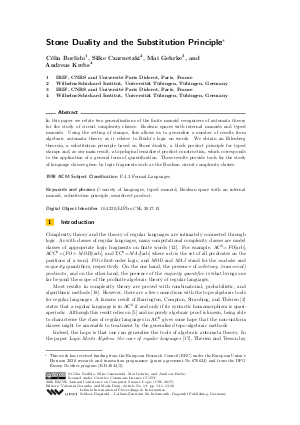Stone Duality and the Substitution Principle
Authors Célia Borlido, Silke Czarnetzki, Mai Gehrke, Andreas Krebs
-
Part of:
Volume:
26th EACSL Annual Conference on Computer Science Logic (CSL 2017)
Part of: Series: Leibniz International Proceedings in Informatics (LIPIcs)
Part of: Conference: Computer Science Logic (CSL) - License:
 Creative Commons Attribution 3.0 Unported license
Creative Commons Attribution 3.0 Unported license
- Publication Date: 2017-08-16
File

PDF
LIPIcs.CSL.2017.13.pdf
- Filesize: 0.57 MB
- 20 pages
Document Identifiers
Subject Classification
Keywords
- C-variety of languages
- typed monoid
- Boolean space with an internal monoid
- substitution principle
- semidirect product
Metrics
- Access Statistics
-
Total Accesses (updated on a weekly basis)
0Document
0Metadata
Abstract
In this paper we relate two generalisations of the finite monoid recognisers of automata theory for the study of circuit complexity classes: Boolean spaces with internal monoids and typed monoids. Using the setting of stamps, this allows us to generalise a number of results from algebraic automata theory as it relates to Büchi's logic on words. We obtain an Eilenberg theorem, a substitution principle based on Stone duality, a block product principle for typed stamps and, as our main result, a topological semidirect product construction, which corresponds to the application of a general form of quantification. These results provide tools for the study of language classes given by logic fragments such as the Boolean circuit complexity classes.
Cite As Get BibTex
Célia Borlido, Silke Czarnetzki, Mai Gehrke, and Andreas Krebs. Stone Duality and the Substitution Principle. In 26th EACSL Annual Conference on Computer Science Logic (CSL 2017). Leibniz International Proceedings in Informatics (LIPIcs), Volume 82, pp. 13:1-13:20, Schloss Dagstuhl – Leibniz-Zentrum für Informatik (2017)
https://doi.org/10.4230/LIPIcs.CSL.2017.13
BibTex
@InProceedings{borlido_et_al:LIPIcs.CSL.2017.13,
author = {Borlido, C\'{e}lia and Czarnetzki, Silke and Gehrke, Mai and Krebs, Andreas},
title = {{Stone Duality and the Substitution Principle}},
booktitle = {26th EACSL Annual Conference on Computer Science Logic (CSL 2017)},
pages = {13:1--13:20},
series = {Leibniz International Proceedings in Informatics (LIPIcs)},
ISBN = {978-3-95977-045-3},
ISSN = {1868-8969},
year = {2017},
volume = {82},
editor = {Goranko, Valentin and Dam, Mads},
publisher = {Schloss Dagstuhl -- Leibniz-Zentrum f{\"u}r Informatik},
address = {Dagstuhl, Germany},
URL = {https://drops.dagstuhl.de/entities/document/10.4230/LIPIcs.CSL.2017.13},
URN = {urn:nbn:de:0030-drops-77060},
doi = {10.4230/LIPIcs.CSL.2017.13},
annote = {Keywords: C-variety of languages, typed monoid, Boolean space with an internal monoid, substitution principle, semidirect product}
}
Author Details
References
-
Jorge Almeida and Pascal Weil. Free profinite semigroups over semidirect products. Russian Mathematics, 39(1):1-27, 1995.

- David A. Mix Barrington, Kevin J. Compton, Howard Straubing, and Denis Thérien. Regular Languages in NC¹. J. Comput. Syst. Sci., 44(3):478-499, 1992. URL: http://dx.doi.org/10.1016/0022-0000(92)90014-A.
- Christoph Behle, Andreas Krebs, and Stephanie Reifferscheid. Typed Monoids - An Eilenberg-like Theorem for non regular Languages. Electronic Colloq. on Comp. Complexity (ECCC), 18:35, 2011. URL: https://eccc.weizmann.ac.il/report/2011/035/.
- Silke Czarnetzki and Andreas Krebs. Using duality in circuit complexity. In Language and Automata Theory and Applications - 10th International Conference, LATA 2016, Prague, Czech Republic, March 14-18, 2016, Proceedings, pages 283-294, 2016. URL: http://dx.doi.org/10.1007/978-3-319-30000-9_22.
- Merrick L. Furst, James B. Saxe, and Michael Sipser. Parity, circuits, and the polynomial-time hierarchy. In 22nd Annual Symposium on Foundations of Computer Science, Nashville, Tennessee, USA, 28-30 October 1981, pages 260-270, 1981. URL: http://dx.doi.org/10.1109/SFCS.1981.35.
- Mai Gehrke. Duality in computer science. In Proceedings of the 31st Annual ACM/IEEE Symposium on Logic in Computer Science, LICS'16, New York, NY, USA, July 5-8, 2016, pages 12-26, 2016. URL: http://dx.doi.org/10.1145/2933575.2934575.
- Mai Gehrke, Serge Grigorieff, and Jean-Eric Pin. A topological approach to recognition. In Automata, Languages and Programming, 37th International Colloquium, ICALP 2010, Bordeaux, France, July 6-10, 2010, Proceedings, Part II, pages 151-162, 2010. URL: http://dx.doi.org/10.1007/978-3-642-14162-1_13.
- Mai Gehrke and Andreas Krebs. Stone duality for languages and complexity. SIGLOG News, 4(2):29-53, 2017. URL: http://dx.doi.org/10.1145/3090064.3090068.
- Mai Gehrke, Andreas Krebs, and Jean-Éric Pin. Ultrafilters on words for a fragment of logic. Theor. Comput. Sci., 610:37-58, 2016. URL: http://dx.doi.org/10.1016/j.tcs.2015.08.007.
- Mai Gehrke, Daniela Petrisan, and Luca Reggio. The Schützenberger Product for Syntactic Spaces. In 43rd International Colloquium on Automata, Languages, and Programming, ICALP 2016, July 11-15, 2016, Rome, Italy, pages 112:1-112:14, 2016. URL: http://dx.doi.org/10.4230/LIPIcs.ICALP.2016.112.
- Mai Gehrke, Daniela Petrişan, and Luca Reggio. Quantifiers on languages and codensity monads. To appear in LICS, 2017. URL: https://arxiv.org/abs/1702.08841.
- Neil Immerman. Descriptive complexity. Graduate texts in computer science. Springer, 1999. URL: http://dx.doi.org/10.1007/978-1-4612-0539-5.
-
Peter T. Johnstone. Stone spaces, volume 3 of Cambridge Studies in Advanced Mathematics. Cambridge University Press, Cambridge, 1986. Reprint of the 1982 edition.

- Andreas Krebs, Klaus-Jörn Lange, and Stephanie Reifferscheid. Characterizing TC^0 in Terms of Infinite Groups. In STACS 2005, 22nd Annual Symposium on Theoretical Aspects of Computer Science, Stuttgart, Germany, February 24-26, 2005, Proceedings, pages 496-507, 2005. URL: http://dx.doi.org/10.1007/978-3-540-31856-9_41.
-
Howard Straubing. Finite Automata, Formal Logic, and Circuit Complexity. Birkhäuser, Boston, Basel, Switzerland, 1994.

- Howard Straubing. On logical descriptions of regular languages. In LATIN 2002: Theoretical Informatics, 5th Latin American Symposium, Cancun, Mexico, April 3-6, 2002, Proceedings, pages 528-538, 2002. URL: http://dx.doi.org/10.1007/3-540-45995-2_46.
- Pascal Tesson and Denis Thérien. Logic meets algebra: the case of regular languages. Logical Methods in Computer Science, 3(1), 2007. URL: http://dx.doi.org/10.2168/LMCS-3(1:4)2007.
- Ryan Williams. Nonuniform ACC circuit lower bounds. J. ACM, 61(1):2:1-2:32, 2014. URL: http://dx.doi.org/10.1145/2559903.
